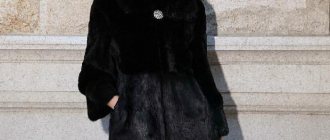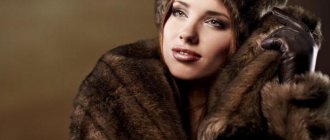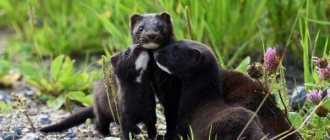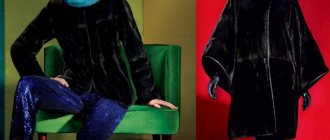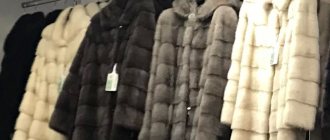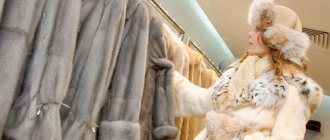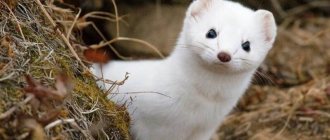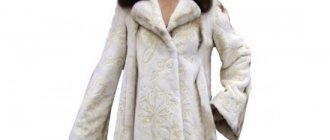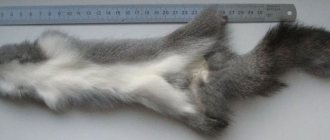Black Canadian mink is considered elite fur. Fur coats, short fur coats and vests made of black mink are incredibly beautiful and very warm. They weigh very little and last a long time. But fur products are not cheap. This is due to the peculiarities of breeding fur-bearing animals.
The fact is that there are a lot of mink farms in Canada. And each of them has its own standards. Growing conditions, nutrition and care are different on each farm. This means that the appearance of the fur varies. It will not be possible to sew a short or long fur coat from the fur of fur-bearing animals raised on different farms. If you ignore this rule, Canadian fur will look slightly different in different areas of the fur garment. It will be noticeable on one fur coat.
What does a Canadian mink look like?
Fur can be safely called velvet. The guard pile is short and very soft. The down is also short and very soft to the touch. If you run your hand over the fur surface, you will get the feeling that you are touching noble velvet.
The second distinctive feature of Canadian fur is its shade. Unlike European or American mink, it does not shine. This fur is matte. Its color cannot be called completely black. If you look closely, a warm brown tint becomes noticeable. It is weakly expressed, so a shade of oil is often attributed to black mink.
Canadian mink coats do not fluff, despite the short guard hair and lush down. But this fur cannot be called completely smooth. The fur is moderately voluminous, soft and incredibly beautiful. In addition to their excellent appearance, fur coats made from elite fur are distinguished by good performance properties:
- Minimum weight. Fur products are very light, so both a knee-length fur coat and a maxi-length model will be comfortable to wear.
- Excellent heat-saving properties. The fur product warms perfectly. With such outerwear you are not afraid of either frost or wind.
- Wear resistance. For all the elegance and softness of fur, it has excellent resistance to mechanical damage, including constant friction. When choosing Black Nafa mink coats, you can be sure that the pile will not break, fall out or wear off after the first season of wear.
- Durability. With proper care, outerwear will last 10 seasons without losing its quality characteristics and new appearance.
Which mink coat to choose?
1
Leave a plus!
It’s still September, but in Moscow and some other Russian cities the first snow has already fallen at night. So it’s time to think about a fur coat. There are a large number of different furs, but if you ask which fur is the most popular in Italy, then the undoubted leader is mink.
A mink coat has long been more than just protection from the cold and not a family heirloom. This is the first rule that a wealthy, respectable woman, a classic of the fashion genre, must follow. If at 20 you can afford a rabbit fur coat, then at 40 you should already consider an elegant mink.
Many people ask how much a mink coat costs in Italy. However, prices for mink can vary dramatically. “Mink”, like “car”, is a very generalized concept. The difference between two mink coats can be no less than the difference between a red Ferrari and a black Volga. If you are going to buy a mink coat, we advise you to take a little time and figure out which mink you should choose.
Although all farmed mink are based on the same American species, depending on the place of breeding and diet, mink fur from different places has completely different properties, which make it possible to conditionally divide the entire mink market into several types.
What kind of mink is there?
Russian mink has high guard hair and thick, high underfur, resulting in a very warm, but somewhat shaggy product.
The Scandinavian mink is the most widespread on the planet. Its quantity accounts for 80% of the world market for farmed mink. The main features are an even awn of medium height and dense underfur. Within the group, both higher fur (Finnish selection, marked SAGA FURS®) and low fur (Danish selection, marked KOPENHAGEN FURS®) can be found.
There is a very rare variety of Finnish mink - the so-called. "polar" mink. This is a brown mink with a pronounced ridge, with very high underfur and a very high awn, which in appearance is more reminiscent of a sable. North American mink is a low-pile mink with a natural velvet effect, since the low, silky spine is almost hidden in the dense, thick and high underfur. There is a so-called “super-short hair”, when the guard hair is below the underfur and the mink has a plucked appearance. High quality and small quantity on the world market have provided this mink with an exclusive place and a high price niche. North American mink can be of two quality systems: American (AMERICAN LEGEND® MINK brand) and Canadian (NAFA® MINK brand). The best black mink in both cases has its own name: the American one is BLACKGLAMA®, and the Canadian one is BLACK NAFA®.
With the growing popularity of low-pile mink, Scandinavian selection is also striving to reduce the height of the pile, and such mink is becoming more and more common in both Finland and Denmark. The “velvet” type (“velvet”, i.e. translated into Russian as “velvet”) is a low-pile (North American-like) variety, separated into a separate sort at Scandinavian auctions. This is not the quality of the pile (within this variety there are any - rare and thick and defective skins), but the appearance. This mink is sold in a separate catalogue, i.e. essentially like another mink. While the quantity of the opposite - long nap mink - is decreasing, within the normal range there are several lots of it, and it is sold as part of the regular catalogue.
In recent years, mink production has increased significantly in China. According to some sources, the number may be about 15 million skins. Since a lot of different gene pools were imported, farms are scattered across different climatic zones, there is no professional training, and not enough time has passed since the start of work, it is impossible to talk about the existence of a separate type of Chinese mink. China raises mink of all types: Russian, Scandinavian and North American. The cheapest Chinese mink is similar to the Russian one of southern breeding - high, hard, lying spine and very weak underfur. The main volume is made up of dark brown (the easiest to breed) and black mink.
Mink colors
The American mink is an ideal object for selective transformations, because... in its genes it carries a huge number of mutations responsible for fur color.
The natural color palette of mink is very large: from white to black, through all brown and gray-blue tones.
The most common color of mink is brown (it is also the cheapest). Its shades make up more than half of the color variations of mink. Natural black mink (the Finnish name is “scanblack”, the prefix “scan” is currently exclusively owned by SAGA), like all natural black fur, is in fact only very dark brown. This is noticeable when comparing it with dyed black furs, leather and fabric.
Dark brown mink is the Russian STK (“standard dark brown”), and the Scandinavian and American “mahogany” is a symbol of the classic mink coat. Variations of the so-called “wild type” repeat the original natural color - brown with a dark ridge. This color has the most official and “folk” names: “wild”, “demi-buff”, “walnut”, “dark pastel”. The light tones of wild type Scandinavian mink are called “(scan)glow”, the dark ones are called “(scan)brown”. The light gray-brown color is called “pastel”. "Lavender" has a light lilac tint and a light undergrowth.
The next group is gray-blue colors. The undisputed leader of this group is the blue mink “sapphire” and its rare light mutation “violet”. This group includes the well-known “silverblue” and the less common gray mink “blue iris”.
White mink is a rare guest on the streets. Much more often you can find darker shades - light beige “pearl” and gray-beige “topaz” (“palomino”).
There are now a large number of different color mutations on the market. The most common of them is the “black cross” mink, in which the black fur of the ridge forms a bright cross on the white skin in the “shoulder” area. The rare variations of the cross are very beautiful - blue (“sapphire cross”) and pastel (“pastel cross”). Crosses are bred in small quantities on the basis of all primary colors. The color of the "jaguar" is reminiscent of the traditional cow - white with black spots.
There are extremely rare mutations of mink, whose worldwide number can be limited to hundreds of skins, for example: gray mink with tiny white inclusions - “stardust”, “cinnamon”, reminiscent of beige milk foam with brown specks on cappuccino cup or marble (“marble”) mink – dark yellow with chocolate stains.
Who to choose: boys or girls minks?
Males are more fluffy and wearable, females are lighter and more tender. Therefore, usually, males are used where weight is not very important (in short products), or if increased fluffiness and thickness are needed. It is better to choose long and/or flared products from females (they are lighter and more flexible).
How is mink processed?
Designers are always trying to change the very texture of mink fur. The most common types of fur processing are plucking and shearing.
When pinched, the guard hair is removed, leaving a velvety underfur. When shearing, the spine is shortened, but if you run your hand over the skin, especially against the grain, you will feel a tingling sensation. Most often, a combination of plucking + cutting technologies is used. After removing the guard hair, the “velvet” is trimmed to the desired height, or “corduroy” is made from the “velvet” (multi-level cutting technology - “grooving”).
Information used: https://mexaimoda.ru/ru/read/interesting/furs/mink.html
- where to buy a mink coat in Italy
- fur products in Italy
- fur coat shopping in Italy
- fur coats in italy
How to spot a fake
Canadian mink is high-quality and expensive fur. It occupies only 5-7% on the world market. Most often, other types of fur are passed off as Canadian. To learn to distinguish them from each other, you need to remember the main characteristics of European, American and Scandinavian minks - these are the species that are usually passed off as elite Canadian.
The second point to remember is the auction number, which is assigned to the fur before being sold at auction. This number, as well as the location of the auction (and for Canadian mink it is always Toronto), must be indicated on the certificate. Before purchasing a fur product, you should definitely ask the seller for a quality certificate. Such an elite product as a fur coat made from Canadian mink must have this document. If the store refuses to provide you with a certificate for some reason, you can safely refuse the purchase, because this is a fake.
And, of course, the BlackNafa brand should be indicated on the fur coat label. If you see the inscription Blackglama on the tag, then they are offering you an American woman. It is also of excellent quality, but differs from the Canadian one. There are also cases when they try to pass off a Canadian mink coat as an outright fake. In order not to fall into the trap and recognize low-quality fur in time, you should pay attention to the following points:
- Fur density. The Canadian has a very dense pile. You definitely won’t be able to push it apart to see the inside with a slight movement.
- A shade of flesh. When you do get there, pay attention to the shade. It should be grayish or beige - this indicates that this is natural, undyed fur. Of course, the Canadian is also tinted, but the flesh always retains its natural shade.
- Toning quality. Take a white handkerchief dampened with water and gently rub it over the surface. If dark marks remain on it, it means that the fur was dyed very poorly and this is not Canadian fur.
- Elasticity. The flesh should be firm and elastic to the touch. If it is dry and rustling, this indicates improper processing of the skins. The lint will begin to fall out of such a fur coat within six months.
- Lining. For Black Nafa fur products, the lining is always made of natural silk. The brand does not use any other materials.

